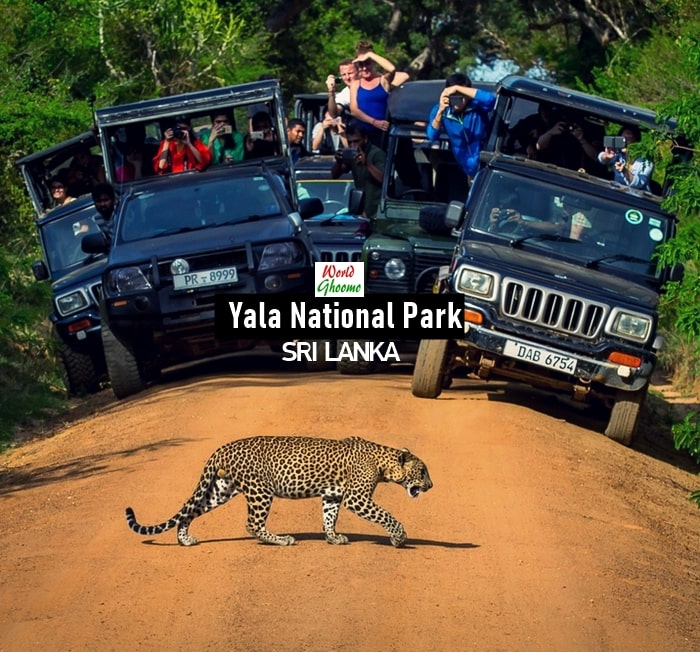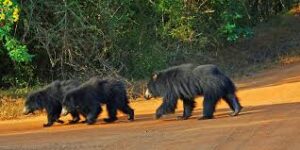
Located in the south-eastern region of Sri Lanka, Yala National Park stands as a testament to the rich diversity of wildlife. As the second largest national park in this island nation, Yala encompasses a wide range of ecosystems from semi-barren reeds to tropical rainforests and marine wetlands on a beautiful
With its diverse ecosystem, Yala boasts of offering some of the most exciting safari experiences in the world. It is 979 square kilometers synonymous with sprawling landscapes, a mosaic of natural wonders waiting to be explored. Here, the thrill of being able to cross paths with a giant Sri Lankan Elephant or watch a herd of elephants emerge from the forest becomes a tangible reality.
Yala’s uniqueness lies not only in its ecological importance but also in the unforgettable experiences it offers. Whether it’s an adrenaline-fuelled safari, peaceful sunsets, whispered peaceful beaches, or grand historical tales, this park commands experiences that last long as its roads are dusted settled there promises.
Ongoing Adventure: Jeep Safari in Yala National Park
A fun way to experience the park’s easy beauty while soaking up the wonder of Yala National Park is through the exciting Jeep Safari route. Here’s a unique opportunity to hike up trails, covered by unspoiled landscapes that host a wealth of biodiversity.
Meeting with the wild
Expect to roam the park grounds under the expansive skies of Sri Lanka, seeing a variety of animals in their natural habitat Yala is known worldwide for its large population of elephants, and offers the best chance of world to see one of these majestic, elusive creatures
Meanwhile, Asian elephants gracefully hang out in the park’s forests, making your safari experience even more unforgettable. The thrill of turning to see a herd of elephants bathed in the golden evening light is truly a heart-pounding moment.
Jeep Safari: The basics
Jeep safaris take you on various routes within the park. There are a variety of tour operators offering these services, ranging from independent carpooling to multi-day tours. Early morning safari rides are common as the park usually opens at 6.00 am. Bookings can also be made for daytime safaris which generally start at 2.30pm, with each activity lasting between 3 and 4 hours.
Safety Instructions
Although a jeep safari in Yala National Park is a wonderful experience, the safety of tourists and wildlife in the park is a major concern. Visitors are advised to follow all instructions provided by the guides. These may include staying in the car at all times, not feeding animals, and keeping quiet, especially around wildlife.
Yala’s Feathered Denizens: Birdwatching Opportunities
With over 215 bird species recorded, Yala National Park is a paradise for bird enthusiasts. The avian wonders of Yala add an entirely new layer to the diversity and beauty of the park.
The Birdlife at Yala
From the flamboyant Peafowl to a multitude of waterbirds residing in the wetland regions, Yala is a treasure trove of bird species. Many are endemic to Sri Lanka, providing a rare viewing opportunity for enthusiastic birdwatchers.
Timing Your Birdwatching Adventure
For the best birdwatching opportunities, the period from November to March is recommended. During these months, many migrant birds travel to Yala, further enhancing diversity. Early mornings or late evenings are when birds are most active and the temperatures are more pleasant for exploration.
Equipping Yourself for Birdwatching
A few essentials can enhance your birdwatching experience in Yala. Binoculars are a must, as they allow for a detailed view of birds at a distance. A field guide can also be useful, helping you identify different bird species and learn about their habits.
Immersed in Wilderness: Camping in Yala National Park
One of the most immersive ways to experience the wild charm of Yala National Park is to opt for a camping expedition within its spans. It’s a magical opportunity, enabling a unique journey into the heart of the Sri Lankan wilderness.
Camping Options
Different camping options cater to a variety of visitor preferences. From basic tents set up in secure zones to luxury camping experiences that offer a blend of wilderness and comfort, there’s something in Yala for every type of adventurer. Several professional providers offer camping packages that include equipment, meals, and safari tours, making it an effortless way to engage genuinely with the park’s wilderness.
Under the Stars, Amidst the Wild
Camping in Yala is not merely about interaction with nature; it’s about becoming part of it, even temporarily. Imagine dusk giving way to a blanket of stars while around you, the sounds of the wild create a harmony unique to Yala. There’s an undeniable thrill in spending the night attuned to the rustle of trees, the distant call of animals, and the soft sigh of the wind.
The Living Tapestry: Biodiversity in Yala National Park
Nature has painted Yala National Park with diversity, creating a wonderful ecosystem. Understanding and appreciating this richness enhances the visitor experience.
Diversity of plants and animals
Yala land is a mixture of forests, grasslands and wetlands. Each of these areas supports a variety of plant and animal species. More than 300 species of flowers have been recorded in the park, many of which are endemic.
In terms of animals, Yala is home to more than 44 mammals and is not only an attraction for bear and rhino lovers. You may see a wild tiger, a sambar, a macaque, or a spotted rhinoceros. There are about 50 species of freshwater fish, amphibians and reptiles, including crocodile predators, which are often seen sunning themselves in the water
Focus is on unique and endangered species
Yala is a sanctuary for many endangered species, a prime example being the leopard (Panthera pardus kotiya) – a rare species that holds the title of being the park’s smallest predator in terms of size in, but not least, the presence of the Toque Macaque (Macaca sinica) . , the world’s 25 Purple-faced Langur appear on the list of the most endangered primates.
Natural environment exposure: Yala waters
Among the many natural attractions in Yala National Park, its water features are particularly breathtaking. The lakes and ponds of the park are relaxing landscapes teeming with life, its beach side brings the rhythmic silence of the sea
Yale lakes and beaches
Yala National Park has many man-made and natural reservoirs or lakes. Some of these, such as Buttuwa Wewa and Yala Wewa, are beautifully peaceful strongholds. Yala also has 60 kilometers of coastline, and is an isolated beach outside the Indian Ocean.
water-based activities
Although motorboating and fishing are strictly regulated to ensure aquatic wildlife is conserved, some approved trips may offer guided wildlife and birding boat trips otherwise , a simple picnic next to one of Yala’s beautiful lakes for a pleasant afternoon.
Ten Wonders of Yala: From Ecosystem Richness to Sublime Sunsets
The Ecosystem Patchwork of Yala
Yala’s rich biodiversity owes to its various ecosystems, ranging from moist monsoon forests and semi deciduous forests to thorn forests, grasslands, freshwater wetlands and marine wetlands.
Such diversity houses a range of unique plant life, from Palu and Weera trees in the forest zones, to mangroves in its wetland ecosystems. Each of these ecosystems plays a vital part in sheltering Yala’s diverse fauna and avifauna.
Chasing Twilight: Sunset Views in Yala
Yala’s expansive landscapes provide ideal vantage points for breathtaking sunset views. As the day transforms into evening, the park takes on golden hues that set the perfect example of natural splendor.
Cultural and Historical Sites Within Yala
Yala National Park, famed for its biodiversity, is also a treasure trove of cultural and historical significance. From ancient Buddhist stupas to the remnants of the Yala Kingdom, the park offers a glimpse into Sri Lanka’s rich past.
Ancient Buddhist Stupas and the Yala Kingdom
- Sithulpawwa Rock Temple: An ancient Buddhist monastery dating back over 2,000 years, it is said to have housed up to 12,000 monks at one point. This site exemplifies the Buddhist heritage within Yala.
- Magul Maha Viharaya: Associated with the Yala Kingdom, this archaeological site includes the ruins of an ancient temple believed to be the setting for a royal marriage in the 2nd century.
Trekking Trails in Yala
Yala National Park offers various trekking trails that cater to different fitness levels, each providing a unique perspective of the park’s diverse ecosystems and wildlife.
Available Trails for Trekking
- Easy Trails: Suitable for most visitors, showcasing the park’s flora and sometimes fauna.
- Moderate Trails: These might cover uneven terrains and require a good fitness level.
- Challenging Trails: For the experienced trekker, offering rugged paths and the chance to explore less-visited areas of the park.
Guided Treks and Benefits
- Guided Treks: Exploring with a local expert not only ensures safety but also enriches the experience, as guides share their knowledge about the park’s biodiversity, cultural sites, and history.
- Benefits: Visitors often find that guided treks reveal hidden aspects of Yala, from lesser-known animal tracks to ancient ruins not marked on standard maps.
Staying on Designated Paths
For the safety of visitors and the protection of the park’s ecosystems, it is crucial to:
- Stay on designated trails at all times.
- Avoid disturbing wildlife or their habitats.
- Be mindful of the park’s guidelines concerning trash disposal and noise levels.
Photography Opportunities
Yala National Park offers a world of unparalleled photo opportunities, making it a dream destination for photographers. From capturing the majestic stance of a leopard to the serene landscapes at dusk, every corner of Yala is a potential masterpiece waiting to be captured.
Tips for Amateur Photographers
- Best Time for Lighting: Early morning or late afternoon is ideal for soft, natural lighting.
- Equipment: A good zoom lens will help capture wildlife from a safe distance.
Photography Etiquette
- Respect Wildlife: Use natural light wherever possible. Flash photography can disturb animals.
- Stay Silent: Keep noise to a minimum to avoid scaring animals away.
Travel Guidelines & Tips
To make the most of your visit to Yala National Park, here are some key guidelines and tips:
- Best Time to Visit: The dry season, from February to June, when animals frequent water holes, offering better wildlife viewing opportunities.
- What to Bring: Sunscreen, hats, and water are essentials. Binoculars and a camera for wildlife sightings and photography.
- Tour Companies: Opt for tours with reputable companies that prioritize responsible wildlife tourism.
conclusion
Yala National Park is a diverse ecosystem, steeped in cultural history, and offers endless opportunities for exploration and photography. Its landscapes and wildlife provide an unforgettable experience for everyone. If you follow the tips and instructions provided, your visit can be enjoyable and respectful of the natural inhabitants of the park.
We encourage you to discover the wonders of Yala National Park, where every visit leaves a lasting impression on the heart and soul. Whether you’re an avid photographer, a history buff, or just appreciate the beauty of nature, Yala promises to be a truly unforgettable trip


